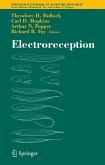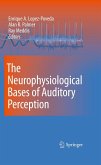M. Norita / T. Bando / B. Stein (eds.)Volume 112
Extrageniculostriate Mechanisms Underlying Visually-Guided Orientation Behavior
Volume 112
Herausgeber: Norita, M.; Stein, B.; Bando, T.
M. Norita / T. Bando / B. Stein (eds.)Volume 112
Extrageniculostriate Mechanisms Underlying Visually-Guided Orientation Behavior
Volume 112
Herausgeber: Norita, M.; Stein, B.; Bando, T.
- Gebundenes Buch
- Merkliste
- Auf die Merkliste
- Bewerten Bewerten
- Teilen
- Produkt teilen
- Produkterinnerung
- Produkterinnerung
The last few years have seen a dramatic increase in the number of areas known to be involved in mammalian vision. It has also seen a far greater understanding of the importance of reciprocal connections, intrinsic connections, structure-specific modules and modules which span different structures, as well as the introduction of parallel processing models within the thalamocortical and corticocortical streams. The body of knowledge has become so vast, and is growing so rapidly, that periodic updates are essential even for experts in the field. This volume is based on a satellite meeting of an…mehr
Andere Kunden interessierten sich auch für
![From Biological to Artificial Consciousness From Biological to Artificial Consciousness]() Masataka WatanabeFrom Biological to Artificial Consciousness31,99 €
Masataka WatanabeFrom Biological to Artificial Consciousness31,99 €![From Biological to Artificial Consciousness From Biological to Artificial Consciousness]() Masataka WatanabeFrom Biological to Artificial Consciousness31,99 €
Masataka WatanabeFrom Biological to Artificial Consciousness31,99 €![Much Like Us Much Like Us]() Norbert SachserMuch Like Us14,99 €
Norbert SachserMuch Like Us14,99 €![Handbook of Mammalian Vocalization Handbook of Mammalian Vocalization]() Handbook of Mammalian Vocalization195,99 €
Handbook of Mammalian Vocalization195,99 €![Electroreception Electroreception]() Electroreception113,99 €
Electroreception113,99 €![The Neural Control of Sleep and Waking The Neural Control of Sleep and Waking]() Jerome SiegelThe Neural Control of Sleep and Waking75,99 €
Jerome SiegelThe Neural Control of Sleep and Waking75,99 €![The Neurophysiological Bases of Auditory Perception The Neurophysiological Bases of Auditory Perception]() The Neurophysiological Bases of Auditory Perception152,99 €
The Neurophysiological Bases of Auditory Perception152,99 €-
-
The last few years have seen a dramatic increase in the number of areas known to be involved in mammalian vision. It has also seen a far greater understanding of the importance of reciprocal connections, intrinsic connections, structure-specific modules and modules which span different structures, as well as the introduction of parallel processing models within the thalamocortical and corticocortical streams. The body of knowledge has become so vast, and is growing so rapidly, that periodic updates are essential even for experts in the field. This volume is based on a satellite meeting of an international group of researchers. It emphasizes the most current information regarding midbrain and extrastriate mechanisms underlying vision and visually-guided behavior. The book also places these data into the larger context of how interrelated components of the visual system function to produce coherent visual experiences and behavior. New research findings are presented that are unavailable elsewhere, as well as reviews and broad perspectives in which existing data from multiple sources are brought together in order to help understand the structure and function of extrageniculostriate visual areas.
Produktdetails
- Produktdetails
- Verlag: Elsevier Science
- Seitenzahl: 447
- Erscheinungstermin: 22. November 1996
- Englisch
- Abmessung: 229mm x 152mm x 19mm
- Gewicht: 1230g
- ISBN-13: 9780444823472
- ISBN-10: 0444823476
- Artikelnr.: 28000918
- Herstellerkennzeichnung
- Libri GmbH
- Europaallee 1
- 36244 Bad Hersfeld
- 06621 890
- Verlag: Elsevier Science
- Seitenzahl: 447
- Erscheinungstermin: 22. November 1996
- Englisch
- Abmessung: 229mm x 152mm x 19mm
- Gewicht: 1230g
- ISBN-13: 9780444823472
- ISBN-10: 0444823476
- Artikelnr.: 28000918
- Herstellerkennzeichnung
- Libri GmbH
- Europaallee 1
- 36244 Bad Hersfeld
- 06621 890
List of Contributors. Preface. 1. Neural mechanisms of visual orienting
responses (J.M. Sprague). 2.
The mosaic architecture of the superior colliculus (R.-B. Illing). 3.
Neurochemical microcircuitry
underlying visual and oculomotor function in the cat superior colliculus
(R.R. Mize). 4. Serotonin
modulates retinotectal and corticotectal convergence in the superior
colliculus (R.D. Mooney et al).
5. Morphology of single axons of tectospinal and reticulospinal neurons in
the upper cervical spinal
cord (Y. Shinoda, S. Kakei, N. Muto). 6. A projection linking motor cortex
with the LM-suprageniculate
nuclear complex through the periaqueductal gray area which surrounds the
nucleus of Darkschewitsch
in the cat (S. Onodera, T.P. Hicks). 7. Firing characteristics of neurones
in the superior colliculus and
the pontomedullary reticular formation during orienting in unrestrained
cats (S. Sasaki, K. Naito, M.
Oka). 8. Ibotenic acid lesions of the superior colliculus produce longer
lasting deficits in visual
orienting behavior than aspiration lesions in the cat (A.C. Rosenquist,
V.M. Ciaramitaro). 9. Spatial
distribution of tectotectal connections in cats (M. Behan, N.M. Kime). 10.
Roles of the lateral
suprasylvian cortex in convergence eye movements in the cats (T. Bando et
al.). 11. Functional
connectivity of the superior colliculus with saccade-related brain stem
neurons in the cat (S. Chimoto
et al.). 12. Visual-auditory integration in cat superior colliculus:
implications for neuronal control of
the orienting response (C.K. Peck). 13. Task-dependence of saccade-related
activity in monkey
superior colliculus: implications for models of the saccadic system (A.J.
Van Opstal, M.A. Frens). 14.
Coding of stimulus invariances by inferior temporal neurons (R. Vogels,
G.A. Orban). 15. Theories
of visual cortex organization in primates: areas of the third level (J.H.
Kaas). 16. Afferent and
developmentally inherent mechanisms of form and motion processing in cat
extrastriate cortex (P.D.
Spear). 17. Extrinsic and intrinsic connections of the cat's lateral
suprasylvian visual area (M. Norita
et al.). 18. Areas PMLS and 21a of cat visual cortex are not only
functionally but also hodologically
distinct (B. Dreher et al). 19. Motion sensitivity and stimulus
interactions in the striate-recipient zone
of the cat's lateral posterior-pulvinar complex (C. Casanova, T. Savard).
20. Comparisons of cross-modality integration in midbrain and cortex (B.E.
Stein, M.T. Wallace). 21. Sensory organization of
the superior colliculus in cat and monkey (M.T. Wallace, B.E. Stein). 22.
Substitution of visual by
auditory inputs in the cat's anterior ectosylvian cortex (J.P.
Rauschecker). 23. Visual, somatosensory
and auditory modality properties along the feline
suprageniculate-AES/insular pathway (Gy. Benedek
et al.). 24. The development of topographically-aligned maps of visual and
auditory space in the
superior colliculus (A.J. King et al.). 25. What do developmental mapping
rules optimize? (M. Xiong,
B.L. Finlay). 26. The effect of damage of the brachium of the superior
colliculus in neonatal and adult
hamsters and the use of peripheral nerve to restore retinocollicular
projections (K.-F. So et al). 27.
A proposed reorganization of the cortical input-output system (Y. Tamai).
28. Neural bases of residual
vision in hemicorticectomized monkeys (M. Ptito et al.). 29.
Extrageniculostriate vision in humans:
investigations with hemispherectomy patients (C.M. Wessinger et al.). 30.
Visual inputs to cerebellar
ventral paraflocculus during ocular following responses (K. Kawano et al.).
31. Context dependent
discharge characteristics of saccade-related Purkinje cells in the
cerebellar hemispheres of the monkey
(N. Mano et al). 32. Further evidence for the specific involvement of the
flocculus in the vertical
vestibulo-ocular reflex (VOR) (K. Fukushima et al.). Subject Index.
responses (J.M. Sprague). 2.
The mosaic architecture of the superior colliculus (R.-B. Illing). 3.
Neurochemical microcircuitry
underlying visual and oculomotor function in the cat superior colliculus
(R.R. Mize). 4. Serotonin
modulates retinotectal and corticotectal convergence in the superior
colliculus (R.D. Mooney et al).
5. Morphology of single axons of tectospinal and reticulospinal neurons in
the upper cervical spinal
cord (Y. Shinoda, S. Kakei, N. Muto). 6. A projection linking motor cortex
with the LM-suprageniculate
nuclear complex through the periaqueductal gray area which surrounds the
nucleus of Darkschewitsch
in the cat (S. Onodera, T.P. Hicks). 7. Firing characteristics of neurones
in the superior colliculus and
the pontomedullary reticular formation during orienting in unrestrained
cats (S. Sasaki, K. Naito, M.
Oka). 8. Ibotenic acid lesions of the superior colliculus produce longer
lasting deficits in visual
orienting behavior than aspiration lesions in the cat (A.C. Rosenquist,
V.M. Ciaramitaro). 9. Spatial
distribution of tectotectal connections in cats (M. Behan, N.M. Kime). 10.
Roles of the lateral
suprasylvian cortex in convergence eye movements in the cats (T. Bando et
al.). 11. Functional
connectivity of the superior colliculus with saccade-related brain stem
neurons in the cat (S. Chimoto
et al.). 12. Visual-auditory integration in cat superior colliculus:
implications for neuronal control of
the orienting response (C.K. Peck). 13. Task-dependence of saccade-related
activity in monkey
superior colliculus: implications for models of the saccadic system (A.J.
Van Opstal, M.A. Frens). 14.
Coding of stimulus invariances by inferior temporal neurons (R. Vogels,
G.A. Orban). 15. Theories
of visual cortex organization in primates: areas of the third level (J.H.
Kaas). 16. Afferent and
developmentally inherent mechanisms of form and motion processing in cat
extrastriate cortex (P.D.
Spear). 17. Extrinsic and intrinsic connections of the cat's lateral
suprasylvian visual area (M. Norita
et al.). 18. Areas PMLS and 21a of cat visual cortex are not only
functionally but also hodologically
distinct (B. Dreher et al). 19. Motion sensitivity and stimulus
interactions in the striate-recipient zone
of the cat's lateral posterior-pulvinar complex (C. Casanova, T. Savard).
20. Comparisons of cross-modality integration in midbrain and cortex (B.E.
Stein, M.T. Wallace). 21. Sensory organization of
the superior colliculus in cat and monkey (M.T. Wallace, B.E. Stein). 22.
Substitution of visual by
auditory inputs in the cat's anterior ectosylvian cortex (J.P.
Rauschecker). 23. Visual, somatosensory
and auditory modality properties along the feline
suprageniculate-AES/insular pathway (Gy. Benedek
et al.). 24. The development of topographically-aligned maps of visual and
auditory space in the
superior colliculus (A.J. King et al.). 25. What do developmental mapping
rules optimize? (M. Xiong,
B.L. Finlay). 26. The effect of damage of the brachium of the superior
colliculus in neonatal and adult
hamsters and the use of peripheral nerve to restore retinocollicular
projections (K.-F. So et al). 27.
A proposed reorganization of the cortical input-output system (Y. Tamai).
28. Neural bases of residual
vision in hemicorticectomized monkeys (M. Ptito et al.). 29.
Extrageniculostriate vision in humans:
investigations with hemispherectomy patients (C.M. Wessinger et al.). 30.
Visual inputs to cerebellar
ventral paraflocculus during ocular following responses (K. Kawano et al.).
31. Context dependent
discharge characteristics of saccade-related Purkinje cells in the
cerebellar hemispheres of the monkey
(N. Mano et al). 32. Further evidence for the specific involvement of the
flocculus in the vertical
vestibulo-ocular reflex (VOR) (K. Fukushima et al.). Subject Index.
List of Contributors. Preface. 1. Neural mechanisms of visual orienting
responses (J.M. Sprague). 2.
The mosaic architecture of the superior colliculus (R.-B. Illing). 3.
Neurochemical microcircuitry
underlying visual and oculomotor function in the cat superior colliculus
(R.R. Mize). 4. Serotonin
modulates retinotectal and corticotectal convergence in the superior
colliculus (R.D. Mooney et al).
5. Morphology of single axons of tectospinal and reticulospinal neurons in
the upper cervical spinal
cord (Y. Shinoda, S. Kakei, N. Muto). 6. A projection linking motor cortex
with the LM-suprageniculate
nuclear complex through the periaqueductal gray area which surrounds the
nucleus of Darkschewitsch
in the cat (S. Onodera, T.P. Hicks). 7. Firing characteristics of neurones
in the superior colliculus and
the pontomedullary reticular formation during orienting in unrestrained
cats (S. Sasaki, K. Naito, M.
Oka). 8. Ibotenic acid lesions of the superior colliculus produce longer
lasting deficits in visual
orienting behavior than aspiration lesions in the cat (A.C. Rosenquist,
V.M. Ciaramitaro). 9. Spatial
distribution of tectotectal connections in cats (M. Behan, N.M. Kime). 10.
Roles of the lateral
suprasylvian cortex in convergence eye movements in the cats (T. Bando et
al.). 11. Functional
connectivity of the superior colliculus with saccade-related brain stem
neurons in the cat (S. Chimoto
et al.). 12. Visual-auditory integration in cat superior colliculus:
implications for neuronal control of
the orienting response (C.K. Peck). 13. Task-dependence of saccade-related
activity in monkey
superior colliculus: implications for models of the saccadic system (A.J.
Van Opstal, M.A. Frens). 14.
Coding of stimulus invariances by inferior temporal neurons (R. Vogels,
G.A. Orban). 15. Theories
of visual cortex organization in primates: areas of the third level (J.H.
Kaas). 16. Afferent and
developmentally inherent mechanisms of form and motion processing in cat
extrastriate cortex (P.D.
Spear). 17. Extrinsic and intrinsic connections of the cat's lateral
suprasylvian visual area (M. Norita
et al.). 18. Areas PMLS and 21a of cat visual cortex are not only
functionally but also hodologically
distinct (B. Dreher et al). 19. Motion sensitivity and stimulus
interactions in the striate-recipient zone
of the cat's lateral posterior-pulvinar complex (C. Casanova, T. Savard).
20. Comparisons of cross-modality integration in midbrain and cortex (B.E.
Stein, M.T. Wallace). 21. Sensory organization of
the superior colliculus in cat and monkey (M.T. Wallace, B.E. Stein). 22.
Substitution of visual by
auditory inputs in the cat's anterior ectosylvian cortex (J.P.
Rauschecker). 23. Visual, somatosensory
and auditory modality properties along the feline
suprageniculate-AES/insular pathway (Gy. Benedek
et al.). 24. The development of topographically-aligned maps of visual and
auditory space in the
superior colliculus (A.J. King et al.). 25. What do developmental mapping
rules optimize? (M. Xiong,
B.L. Finlay). 26. The effect of damage of the brachium of the superior
colliculus in neonatal and adult
hamsters and the use of peripheral nerve to restore retinocollicular
projections (K.-F. So et al). 27.
A proposed reorganization of the cortical input-output system (Y. Tamai).
28. Neural bases of residual
vision in hemicorticectomized monkeys (M. Ptito et al.). 29.
Extrageniculostriate vision in humans:
investigations with hemispherectomy patients (C.M. Wessinger et al.). 30.
Visual inputs to cerebellar
ventral paraflocculus during ocular following responses (K. Kawano et al.).
31. Context dependent
discharge characteristics of saccade-related Purkinje cells in the
cerebellar hemispheres of the monkey
(N. Mano et al). 32. Further evidence for the specific involvement of the
flocculus in the vertical
vestibulo-ocular reflex (VOR) (K. Fukushima et al.). Subject Index.
responses (J.M. Sprague). 2.
The mosaic architecture of the superior colliculus (R.-B. Illing). 3.
Neurochemical microcircuitry
underlying visual and oculomotor function in the cat superior colliculus
(R.R. Mize). 4. Serotonin
modulates retinotectal and corticotectal convergence in the superior
colliculus (R.D. Mooney et al).
5. Morphology of single axons of tectospinal and reticulospinal neurons in
the upper cervical spinal
cord (Y. Shinoda, S. Kakei, N. Muto). 6. A projection linking motor cortex
with the LM-suprageniculate
nuclear complex through the periaqueductal gray area which surrounds the
nucleus of Darkschewitsch
in the cat (S. Onodera, T.P. Hicks). 7. Firing characteristics of neurones
in the superior colliculus and
the pontomedullary reticular formation during orienting in unrestrained
cats (S. Sasaki, K. Naito, M.
Oka). 8. Ibotenic acid lesions of the superior colliculus produce longer
lasting deficits in visual
orienting behavior than aspiration lesions in the cat (A.C. Rosenquist,
V.M. Ciaramitaro). 9. Spatial
distribution of tectotectal connections in cats (M. Behan, N.M. Kime). 10.
Roles of the lateral
suprasylvian cortex in convergence eye movements in the cats (T. Bando et
al.). 11. Functional
connectivity of the superior colliculus with saccade-related brain stem
neurons in the cat (S. Chimoto
et al.). 12. Visual-auditory integration in cat superior colliculus:
implications for neuronal control of
the orienting response (C.K. Peck). 13. Task-dependence of saccade-related
activity in monkey
superior colliculus: implications for models of the saccadic system (A.J.
Van Opstal, M.A. Frens). 14.
Coding of stimulus invariances by inferior temporal neurons (R. Vogels,
G.A. Orban). 15. Theories
of visual cortex organization in primates: areas of the third level (J.H.
Kaas). 16. Afferent and
developmentally inherent mechanisms of form and motion processing in cat
extrastriate cortex (P.D.
Spear). 17. Extrinsic and intrinsic connections of the cat's lateral
suprasylvian visual area (M. Norita
et al.). 18. Areas PMLS and 21a of cat visual cortex are not only
functionally but also hodologically
distinct (B. Dreher et al). 19. Motion sensitivity and stimulus
interactions in the striate-recipient zone
of the cat's lateral posterior-pulvinar complex (C. Casanova, T. Savard).
20. Comparisons of cross-modality integration in midbrain and cortex (B.E.
Stein, M.T. Wallace). 21. Sensory organization of
the superior colliculus in cat and monkey (M.T. Wallace, B.E. Stein). 22.
Substitution of visual by
auditory inputs in the cat's anterior ectosylvian cortex (J.P.
Rauschecker). 23. Visual, somatosensory
and auditory modality properties along the feline
suprageniculate-AES/insular pathway (Gy. Benedek
et al.). 24. The development of topographically-aligned maps of visual and
auditory space in the
superior colliculus (A.J. King et al.). 25. What do developmental mapping
rules optimize? (M. Xiong,
B.L. Finlay). 26. The effect of damage of the brachium of the superior
colliculus in neonatal and adult
hamsters and the use of peripheral nerve to restore retinocollicular
projections (K.-F. So et al). 27.
A proposed reorganization of the cortical input-output system (Y. Tamai).
28. Neural bases of residual
vision in hemicorticectomized monkeys (M. Ptito et al.). 29.
Extrageniculostriate vision in humans:
investigations with hemispherectomy patients (C.M. Wessinger et al.). 30.
Visual inputs to cerebellar
ventral paraflocculus during ocular following responses (K. Kawano et al.).
31. Context dependent
discharge characteristics of saccade-related Purkinje cells in the
cerebellar hemispheres of the monkey
(N. Mano et al). 32. Further evidence for the specific involvement of the
flocculus in the vertical
vestibulo-ocular reflex (VOR) (K. Fukushima et al.). Subject Index.








